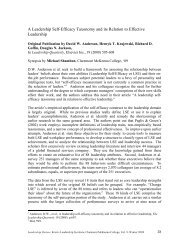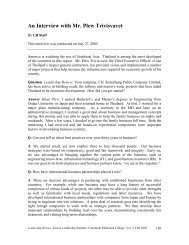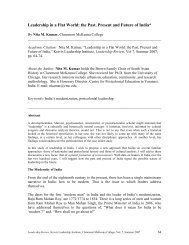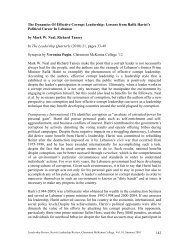125 Leadership Styles in Competing Organizational Cultures By ...
125 Leadership Styles in Competing Organizational Cultures By ...
125 Leadership Styles in Competing Organizational Cultures By ...
Create successful ePaper yourself
Turn your PDF publications into a flip-book with our unique Google optimized e-Paper software.
leadership styles work best <strong>in</strong> different organizational cultures (Alvesson, 2002). Thisleadership-culture relationship significantly <strong>in</strong>fluences the performance of organizationsand requires further <strong>in</strong>vestigation (Block, 2003)Researchers have been discuss<strong>in</strong>g the def<strong>in</strong>ition of leadership for many years withdiffer<strong>in</strong>g results but most agree that leaders have a perceived <strong>in</strong>fluence on organizationalmembers (Bohn & Grafton, 2002; Rost, 1991; Yukl, 1989). There are differences <strong>in</strong> howto <strong>in</strong>vestigate leadership and the development of different measurements of leadershipstyles (Yukl, 1989). One of the most researched and <strong>in</strong>fluential frameworks for leadershipis the theory of transformational and transactional leadership developed by Burns(Eisenbach, Watson, & Pillai, 1999; Parry, 2002). While there are alternativesframeworks for describ<strong>in</strong>g leadership, transformational leaders have received muchresearch attention and are <strong>in</strong>cluded <strong>in</strong> this study because they are very effective atachiev<strong>in</strong>g organizational goals and outperform<strong>in</strong>g other styles of leadership (Yammar<strong>in</strong>o,Spangler, & Bass, 1990).<strong>Organizational</strong> culture may be def<strong>in</strong>ed as a common set of values and beliefs that areshared by members of an organization which <strong>in</strong>fluences how people perceive, th<strong>in</strong>k, andact (Sche<strong>in</strong>, 1990). Culture becomes a basic set of assumptions that guides anorganization’s social relationships and are moderated by an unspoken socializationprocess, which is often taken for granted by vested members. This value system is usedas a reference by members as they make decisions <strong>in</strong> the performance of their duties.Moreover, organizational performance has been directly l<strong>in</strong>ked to organizational culture(Berrio, 2003).<strong>Leadership</strong> styles and organizational culture are not <strong>in</strong>dependent of each other. Researchhas shown there is constant <strong>in</strong>terplay between leadership and organizational culture (Bass& Avolio, 1993; Berrio, 2003; Parry, 2002). Bass and Avolio (1993) found that anorganization’s culture derives from its leaders and culture affects the development of itsleadership. Furthermore, effective leaders need to be attentive to beliefs, values andassumptions <strong>in</strong> an organization, <strong>in</strong> short, the culture. <strong>By</strong> hav<strong>in</strong>g higher levels ofemotional <strong>in</strong>telligence, these leaders can understand the emotions of followers and the<strong>in</strong>fluence of organizational culture on the situation (Barl<strong>in</strong>g, Slater, & Kelloway, 2000).Leaders may use this understand<strong>in</strong>g of the culture and its effect on the organizationalmembers to aid them <strong>in</strong> select<strong>in</strong>g optimal leadership techniques. Hart and Qu<strong>in</strong>n (1993)found that managers are more effective when they are culturally complex. They havemore tools to deal with different situations. Lok and Crawford (1999) determ<strong>in</strong>ed thereare different leadership behaviors correlated with specific cultural traits. Furthermore,culture has also been measured as a strong <strong>in</strong>fluence to both organizational success andachievements of the leader (Berrio, 2003). Therefore, it is important to know which stylesof leadership are found <strong>in</strong> specific types of organizational culture.The purpose of this study was to determ<strong>in</strong>e which leadership styles, the dependentvariable, are found <strong>in</strong> specific types of organizational cultures, the <strong>in</strong>dependent variable.The method to <strong>in</strong>vestigate this relationship was to conduct an exploratory survey of manyorganizations to determ<strong>in</strong>e correlations l<strong>in</strong>k<strong>in</strong>g cultures with leadership styles. This<strong>Leadership</strong> Review, Kravis <strong>Leadership</strong> Institute, Claremont McKenna College, Vol. 10, Summer 2010 126






